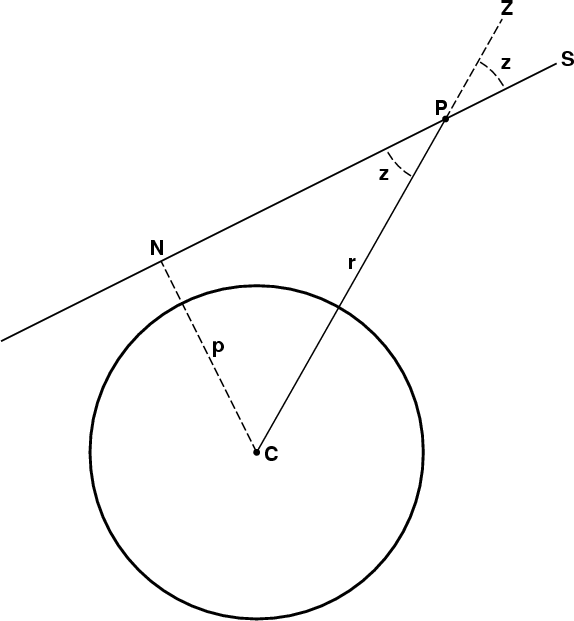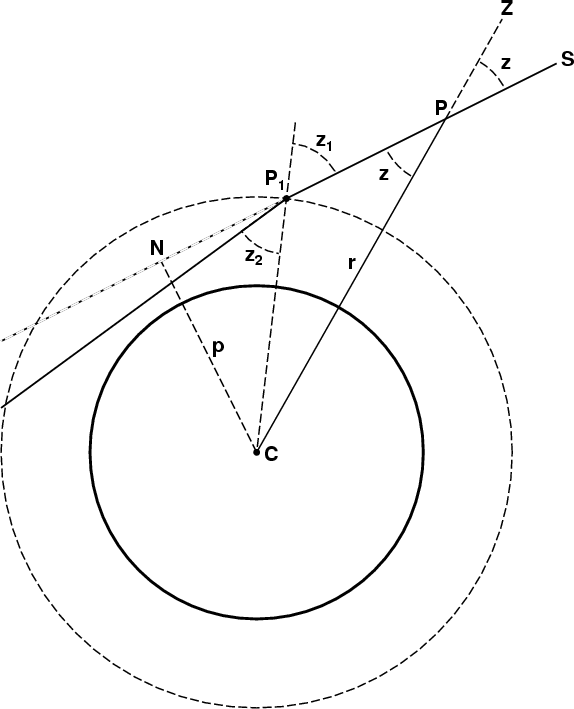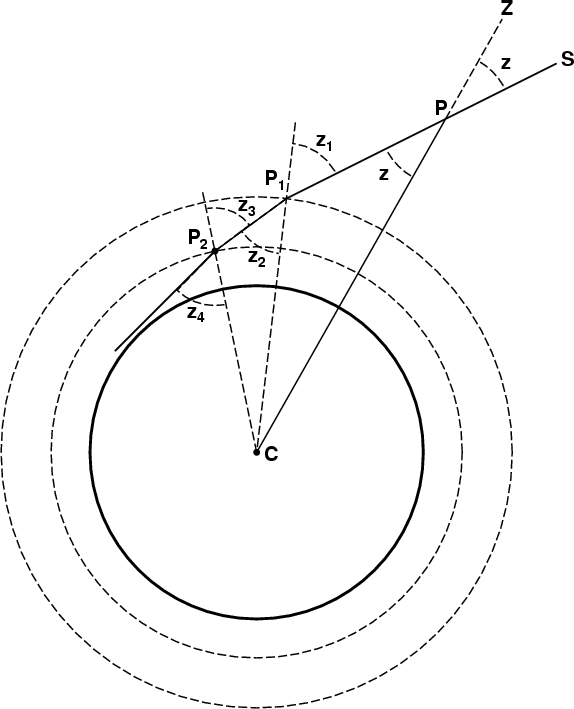The Refractive Invariant
Introduction
To understand atmospheric refraction quantitatively, you have to
understand how
Snel's Law
works in a spherical atmosphere. This requires only the most elementary
trigonometry; just the definitions of sines and cosines are enough to
let you follow the argument.
Spherical atmosphere without refraction
To begin with, consider just the geometry of a spherical atmosphere,
without refraction.
Here's a figure to illustrate this: the big circle centered at C
represents the Earth's surface, and the heavy line NPS represents a ray of light
coming from a star or the Sun, say, off to the right somewhere in the
direction of S. (The plane of the figure is the plane determined by the
incoming straight ray NPS and the center of the Earth, C.)
 The line CPZ is the local vertical passing through some arbitrary point P
on the ray, so that PZ points in the direction of the zenith at P.
You can see that the angle ZPS is the local zenith distance, z,
of the ray at P.
And, because CPZ and NPS are straight lines, the angle CPN is also the
zenith distance z.
The line CPZ is the local vertical passing through some arbitrary point P
on the ray, so that PZ points in the direction of the zenith at P.
You can see that the angle ZPS is the local zenith distance, z,
of the ray at P.
And, because CPZ and NPS are straight lines, the angle CPN is also the
zenith distance z.
Now draw the perpendicular from C to the ray NPS, and assume that N is in
fact the foot of this perpendicular, which is drawn as a dashed line in
the diagram.
(That makes N the nearest point to C on the ray.)
The angle CPN is now an angle of the right triangle CPN.
Bearing in mind that the angle CPN is also the zenith distance z of the
ray at P, we recall from elementary trigonometry that the ratio of the
length of the perpendicular CN (of length p) to the hypotenuse of the
triangle, CP (of length r), is just the sine of the opposite angle; that
is,
p/r = sin z .
(That's just the definition of the sine of an angle: the opposite side
divided by the hypotenuse. You're probably not used to seeing a right
triangle turned upside down like this.)
If we clear this of fractions by multiplying both sides by the radial
distance, r, from C to P, we have
p = r sin z .
Notice that this equality holds for every point P along the ray.
That is, if P slides back and forth along the (fixed) ray SN, the zenith
angle z at P always changes so that the changes in sin z
exactly compensate for the changes in radial distance r:
their product p remains invariant.
We haven't said anything about refraction yet. This is just basic
geometry so far. We might call (r sin z)
the geometric invariant, to
distinguish it from the refractive invariant we will find later.
A refracting interface
Now, let's add a refracting atmosphere to our diagram. We assume it has a
horizontal surface — i.e., a sphere concentric with the Earth.
So let the dashed circle added in the figure below represent this surface,
of radius r1.

The original ray meets this surface at P1, where it is
refracted instead of continuing along the original path (now shown dotted)
through N.
Because the local vertical at P1 has the direction CP1,
which is different from CP, the local zenith distance of the incoming ray
is z1 at P1.
For simplicity in calculating the refraction at P1, let us
assume
Cassini's oversimplified model
for the moment: the atmosphere is
homogeneous below the refracting surface, and there is vacuum above it.
That is, the surface is the “top of the atmosphere” very literally.
Then the refractive index on the incident (upper) side of the surface
n1 = 1.000 exactly, and the refractive index on the lower
side is that of air — call it n2 for convenience.
Now the refractive index of air, n2, is bigger than unity;
so Snel's Law tells us that the angle of refraction z2 must
be smaller than the angle of incidence z1, because the law
of refraction at P1 is just
n1 sin z1 =
n2 sin z2 ,
or
sin z1 = n2 sin z2
in our particular case, where n1 = 1 exactly.
Now, multiply this last equation by the value of r at P1,
which is r1:
r1 sin z1 =
n2 r1 sin z2 .
From the argument at the end of the previous section, we see that
the left side of this equation is just the perpendicular length, p.
(The value of the product r sin z is p at
every point along the original ray; in particular,
it is p at the point P1,
so that r1 sin z1 = p .)
Therefore, the right side is also equal to p.
This is a remarkable result: even after refraction, the product
(n r sin z)
is still equal to the length of the original
perpendicular, p. That's because the invariance of the product
(n sin z)
across the refracting surface allows us to replace
(n sin z)
on the lower side with its value on the upper side, where n was unity.
Furthermore, the geometric invariant applies to the ray after
refraction: the product (r sin z)
is the same everywhere below P1.
And, as the refractive index is also constant
throughout the lower layer, the product
(n r sin z)
is also constant there, and equal to its value p at P1.
Because (n r sin z) is the same
everywhere along the refracted ray, and remains invariant even after
refraction, we call it the refractive invariant.
Two refractions
Obviously, Cassini's homogeneous atmosphere is not very realistic. We
really need to deal with an atmosphere made of many different layers.
Suppose, as a start, that we
add a second refracting surface below the one considered above.
Then the once-refracted ray is refracted a second time when it
meets this second interface, at a point we can call P2.
As mentioned above, the geometric invariant applies
to the (straight) refracted ray between the first and second surfaces:
the value of (r sin z) at
every point along the segment P1P2
is constant, and equal to the length of the
perpendicular to this straight ray segment from the center, C.

In particular, when the ray meets the second refracting surface at
P2, the value of (r sin z)
there is the same
as its value at P1. This value, of course, is the length of
the perpendicular from C to the once-refracted ray
P1P2 ;
I refrain from adding this line to the diagram, which is already rather
cluttered. Let us call this length p1.
But we know (from the result of the previous section) that
n1p1 is just p,
the length of the original perpendicular CN in vacuum.
Then, applying Snel's Law again at P2 gives
n1 sin z3 =
n2 sin z4 ,
where z3 is the angle of incidence at P2 (from the
medium with refractive index n1), and z4
is the angle of refraction into the lowest layer, with refractive index
n2.
Consequently, multiplying by r2, we have
n1 r2
sin z3 =
n2 r2
sin z4 .
But the geometric invariant along a straight line allows us to replace
r2 sin z3
with the corresponding value of this
product at P1, namely
p1 =
r1 sin z2 .
So the left side of this equation becomes
n1 r1 sin z2 .
And, as we already showed that this equals
r1 sin z1
or p, we see that this refractive invariant
is still preserved after a second refraction;
the right side of the last centered equation is just
the value of (n r sin z)
after the second refraction.
And so ad infinitum . . .
Clearly, this process can be repeated as many times as we like.
No matter how many layers there are, the refractive invariant
(n r sin z) remains equal to p
in every layer.
We can now extend this process to infinitely many, infinitely thin
layers — in other words, to a continuous variation of the refractive
index n with height in the atmosphere.
The result will always be the same: the
refractive invariant is always equal to p, everywhere along the ray:
n r sin z = p .
This fundamental equality is the basis for ray-tracing through any
atmospheric model. For the model gives n as a function of r;
then the local slope of the ray can be found from sin z.
Those readers who know calculus will see that the path of the ray can be
traced if its local slope is known everywhere; differentiating the
refractive invariant equation above
provides a differential equation
from which everything we need can be calculated. But this goes beyond the
scope of the present page.
Concluding remarks
What else is the invariant good for?
In addition to providing the basic equation that allows ray-tracing in the
atmosphere, the refractive invariant can be used to inspect the properties
of rays, without detailed calculations.
Here are a few examples; let p be the value of the invariant for a ray.
Shape of a ray path
First of all, because (sin z) is symmetrical about
z = 90°, rays that have a maximum or (more often)
a minimum are symmetrical about this extremum. This
symmetry is discussed on another page; and
there will be more to say about these extrema below.
Second, if (nr) is a monotonically increasing
function of r, (sin z) = p/nr
(and therefore z itself) must decrease
monotonically with r; so any ray initially above the horizon
approaches the local zenith as we trace it outwards, away from the observer.
This means the ray can be nearly horizontal only in the lowest layers of
the atmosphere; in the upper atmosphere, the local zenith distance is
smaller, and the ray crosses the upper layers more obliquely
than the lower ones. So the ray path is less in an upper layer than in a
lower one of the same geometric thickness. This is basically why the
upper atmosphere has only a very weak effect on refraction: it can never
be traversed at grazing incidence.
Comparing the paths of different rays
Bear in mind that p has the same value at all
points along a given ray. However, another ray, coming from a different
direction in space, will have a different slope
from the first at each height above the surface, and so a different
value of p.
Let's compare two rays passing through the observer's eye.
At the eye, they have different slopes, and so must have different values
of the invariant. As the factor (nr) is the same for both rays at any
given height, the ray with the larger p must also have a larger
value of (sin z): the ray with the steeper slope at
the eye remains steeper than the other ray at every other height as well,
just as if the rays were straight.
So, if both rays are above the
astronomical horizon at the observer,
the rays diverge as they recede from the eye.
That means the rays cannot cross anywhere but at the eye; the image seen
is necessarily erect. This result is
important for mirages.
Conditions for mirages
To have a mirage, we need to have two (or more) paths from the same object
point to the eye.
That is, two different rays at the eye, traced back to the object, must
intersect there.
But we have just shown that two rays above the horizon at the observer's
eye cannot cross, if (nr) is monotonic; so they cannot produce a mirage.
Then how are mirages possible?
We can only get a mirage if a ray is horizontal
somewhere along the line of sight, so that r does not change monotonically
along the ray.
If (nr) is a monotonic function of r, the ray is horizontal at
its minimum height above the Earth.
Then we see a ray that arrives at the eye from below our
astronomical horizon.
This is the case for the inferior mirage: the inverted image is always
below the astronomical horizon.
Another possibility is that the ray is horizontal at a maximum height.
We can see such rays slightly above (though still very near) the astronomical
horizon.
But for this case, we require that (nr) is not a monotonic function
of r; it must have a local maximum.
Rays near this maximum can be trapped in a
duct.
From within the duct, we can
see inverted images of distant objects that are also in the duct; this is
the classical superior mirage.
Of course, we cannot see celestial objects in the zone at the astronomical
horizon that is
blocked
by the duct.
Consequently, mirages of celestial objects — which includes most green
flashes — are seen only below the astronomical horizon.
The theorem that inverted images require rays to be horizontal somewhere
between the object and the observer, so that
only erect images are normally seen above the astronomical horizon (in a
horizontally-layered atmosphere) was implied by J. B. Biot
in his 1810 monograph
on mirages, and explicitly stated in H. W. Brandes's 1814
abridged translation
of it into German. It is also explicitly stated by Rudolf Meyer in
his 1935 review
of refraction and mirage phenomena: “The necessary and sufficient
condition for a mirage is the horizontal direction of the ray at some
place between beginning and end.”
The divergence of rays from the observer above the horizon
is very nicely proved by Meyer on pp. 776–777 of his
Handbuch der Geophysik
article, using essentially the same argument presented here.
Meyer states explicitly on p. 800 that inverted images
of heavenly bodies are therefore visible only below the horizon.
Because a ray must be horizontal between the observer and the miraged
object, only objects beyond the
apparent horizon
are seen miraged
(inverted). (This rule is violated in the common inferior mirages seen on
paved roads, because the paving is not perfectly level; all the foregoing
discussion assumes a perfectly stratified atmosphere, and this assumption
is violated in the surface layer next to a hot, uneven road.)
Where a ray is horizontal, the local value of z is 90°,
and sin z = 1.
At this point, which must be either a maximum or a minimum in height
along the ray, n r = p.
This condition makes it easy to find where the ray turns back into layers
it has traversed before, if we know its slope at any point along the ray.
Dip of the horizon
In particular, a ray must be horizontal at the sea horizon. Knowing
the refractivity profile and the height of the eye, we can then calculate
the dip
of the horizon directly without doing any ray-tracing; for
(n r sin z) at the eye
must equal (n r) at the
horizon. As the dip is the negative of the altitude,
which is the complement of the zenith distance, we have
cos (dip) = sin z =
nhor rhor
/ neye reye .
This relation suggests that the quantity (n r)
as a function of
height would be very informative; and indeed, a plot of nr vs.
height is the dip diagram,
which is discussed in detail
elsewhere.
Ducts
The nr product is also the key to understanding
ducts,
which are
regions bounded by two layers with the same value of nr.
Because nr is the same at the top and bottom of a duct, any ray
passing through these two levels has the same value of sin z
(and therefore the same value of z) at both
of them. A ray that is horizontal within the duct has a larger
value of nr than those at its boundaries, and so cannot reach them;
for that would require it to have sin z greater than unity at the
duct boundary, to keep (nr sin z) constant.
Such rays are trapped within the duct —
hence
the name.
A ray that is horizontal at the edge of a duct is forced to circle the
Earth at constant height indefinitely, assuming a horizontally-uniform
atmosphere. These circulating rays are discussed on
another page.
Copyright © 2002, 2005, 2006, 2009, 2012, 2014 Andrew T. Young
Back to the ...
astronomical refraction page
or the
main mirage page
or the
GF home page
 The line CPZ is the local vertical passing through some arbitrary point P
on the ray, so that PZ points in the direction of the zenith at P.
You can see that the angle ZPS is the local zenith distance, z,
of the ray at P.
And, because CPZ and NPS are straight lines, the angle CPN is also the
zenith distance z.
The line CPZ is the local vertical passing through some arbitrary point P
on the ray, so that PZ points in the direction of the zenith at P.
You can see that the angle ZPS is the local zenith distance, z,
of the ray at P.
And, because CPZ and NPS are straight lines, the angle CPN is also the
zenith distance z.

